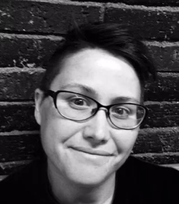I was skeptical that I would find a connection with the stories ...
I came out at 16 as a butch dyke and I learned quickly that the cultural gap
between the experiences of gay men and lesbians was wide ...
And so, as I read the book, I was pleasantly surprised to find myself nodding along.
I came out at 16 as a butch dyke and I learned quickly that the cultural gap
between the experiences of gay men and lesbians was wide ...
And so, as I read the book, I was pleasantly surprised to find myself nodding along.
|
When I was asked to review Fashionably Late: Gay, Bi & Trans Men Who Came Out Later in Life I was skeptical that I would find a connection with the stories inside. I came out at 16 as a butch dyke and I learned quickly that the cultural gap between the experiences of gay men and lesbians was wide. Burned by too many experiences of sexism and its queer companion, classism, I had kept my distance from gay, cisgender men. And so, as I read the book, I was pleasantly surprised to find myself nodding along.
Because its focus is about coming out later in life, this book is also about the cultural conditions that lead to coming out later: internalized homophobia, rurality, conservative strands of Christianity, and the rigidly enforced edges of heterosexuality and gender normativity. I was raised in a rural, predominantly white and conservative Christian area of the U.S. As a result, and because of my own journey with a transmasculine identity, I related to many aspects of the stories in this collection. I was a born-again, evangelical Christian before I came out. Even though I’d only endured two years of creepy brainwashing tactics, as a teenager it took what felt like a mammoth feat of psychic maneuvering to make that transition from born-again to an out, and self-loving, lesbian feminist. After his anxiety-ridden coming out, Kamal’s Sikh, Indian-Canadian parents both respond with “Why did you wait so long?” Many of the men in this anthology took a different path at that adolescent faith-and-identity crossroads. Their stories are a window into how internalized homophobia is stoked by conservative strains of Christianity. Van Waffle’s “Snow Fell Out of Darkness” navigates this coming-out-while-Christian crisis by delving deeper into conservative strands of faith. The struggle for self- and community acceptance pushed Waffle into the arms of evangelical Christianity.
Reading an old bible one night he recalls: “I happened to flip to the back cover and found for the first time the sinner’s prayer, in which a lost soul could find salvation by asking Jesus Christ into his or her life… It was perfect. It confirmed my belief that the world was a sad and dingy place, that some flaw of nature had determined that I should suffer. If only I resisted the pull of evil until I died, everything would be fine.” |
In following Waffle’s struggles through the ex-gay movement—his attempts at a loving and honorable marriage with an evangelical woman, and finally leaving the church—his story unfolds not as a series of events that led to life as an openly gay man, but, rather, it reads like we are passengers inside a kayak swept along in the current of his emotional turmoil as he tries over and over to do “the right thing.” With each stop on his journey, he’s sure the dock is moored in what is right and good. And each time, sad and disappointed, we are dropped back into the river and swept off again.
Joseph Schreiber’s raw story, “Fracturing the Mirror of Invisibility,” reveals the debilitating effects of isolation; a stark reminder that depression, anxiety, and other mental health challenges are so often a dangerous and under-resourced part of the LGBT experience. Schreiber’s account of transitioning to live as a man while married to a man and with two young children also resonated with me as a transmasculine parent. However, his life as a gay transman with no connections to the lesbian community feels unique to many transmasculine narratives. He transitioned from a life lived as a straight woman to a life as a gay man while staying right where he was in his small community and raising his kids. At the end, his cautious integration into a gay- and trans-affirming faith community is a nugget of faith-based optimism to counter-balance the harms done by Christian communities to other authors in Fashionably Late. Vinnie Kinsella the editor of Fashionably Late was leader of a Portland, Oregon-based support group for men who came out later in life. When curating a collection like this, perhaps the most important thing is that the editor be open to writing about someone's deepest, most intimate struggles and desires, which clearly—given his leading of this group--Kinsella is. Fashionably Late reflects the trust writers must have had in Kinsella. It feels intimate and thoughtful, the distillation of many years of unpacking each man’s trajectory towards transformation. A noted downside of this anthology is that it reflects the homogeneity of Kinsella's existing social circles and geographic locales. In this case, the central hub for several of these writers is Portland, Oregon—a city with an overwhelmingly white population. There are few stories in the book written by men of color. |
In one of them, Patrick Cornelius, a black trans man who started testosterone at 43, wrote “One thing that I never considered when starting my transition was how my race and gender would intersect. I had no idea what the effect of being seen as an African American male in America would have on me. I’m not sure what world I was living in before, but I was so oblivious. I now notice not only women’s fear of men in general, but also some white women’s greater fear of Black men. I also notice how the fear and hatred for Black men is so woven into our American culture that many people don’t even realize how pervasive it is.”
Cornelius’s reflection not only offers valuable insight into how changing gender changes the experience of race, it also highlights the lack of reflection on race and gender in much writing penned by white, cisgendered men. He transitioned from a life lived as a straight woman to a life as a gay man while staying right where he was in his small community and raising his kids. While many of the stories in the collection necessarily convey the heaviness that comes with coming out under trying conditions, some of them, like “Caged” by Anil Kamal, also share joy. After his anxiety-ridden coming out, Kamal’s Sikh, Indian-Canadian parents both respond with “Why did you wait so long?” They sit down and watch Saturday Night Live. So mote it be for all LGBTQ people.
Because white men’s stories comprise most of the stories, Fashionably Late can at times feel almost repetitive—middle-class or rural, working-class white Christian men struggling with the intense pressures of anti-gay, evangelical, and heterosexual-family focused on social expectations. I appreciate that the book turns away from stories in which men write themselves as universally triumphant or who shaped themselves into a facsimile of a stereotypical gay men. Even with these limitations, the stories in this book are vivid; real lives of real, complicated men. As a stand-alone work, it is a valuable contribution to the canon of coming out anthologies that, as a historical collection, document LGBTQ life through first-person accounts. |

REVIEWED BY GROVER WEHMAN-BROWN
Grover Wehman-Brown is a writer living in the hills of Western Massachusetts. Her essays have appeared online in venues such as The Establishment, The Huffington Post, and Greatist. She is currently writing a poetry manuscript that examines dyke and transmasculine ancestry. You can find out more at www.groverwehmanbrown.com.
Grover Wehman-Brown is a writer living in the hills of Western Massachusetts. Her essays have appeared online in venues such as The Establishment, The Huffington Post, and Greatist. She is currently writing a poetry manuscript that examines dyke and transmasculine ancestry. You can find out more at www.groverwehmanbrown.com.
